Responses of Bed Morphology to Vegetation Growth and Flood Discharge at a Sharp River Bend
Abstract
:1. Introduction
2. Material and Methods
2.1. Computational Conditions
2.1.1. Hydrodynamic Model
2.1.2. Vegetation Model
2.1.3. Non-Equilibrium Secondary Flow Model for Sediment Transport of Bed Load
2.1.4. Sediment Transport Model
2.1.5. Slope Failure Model
2.1.6. Hydrograph Characteristic Shape
- Flood events, with the annual maximum peak, were selected from 15 years of measurement data (see Figure 4), except for the 2015, as the hydrograph for this year shows less than half of the annual averaged maximum discharge (690 m3/s) of the other years. Thus, a total of 14 hydrographs were extracted from 15 years’ data;
- Each hydrograph was normalized using each peak discharge and then trimmed at the inflection points;
- And then, the hydrograph characteristic shape was calculated by ensemble averaging with all of 14 normalized hydrographs. Before taking ensemble averaging, the start times of all hydrographs were adjusted so that the times to peaks become the same. We also assumed that the discharge at the start and the end of the hydrograph is the total averaged discharge for 15 years. As a result, the flood duration of the hydrograph characteristic shape becomes 150 h.
2.2. Verification of Simulation
2.3. Channel Pattern Quantification
2.3.1. Braiding Index
2.3.2. Bed Relief Index
3. Results and Discussion
3.1. Local Erosion and Global Erosion
3.2. Final Channel Patterns and Distribution of Vegetation Area
3.3. Change in the ABI and BRI over Time
3.4. Bar and Thalweg Dynamics under Different Levels of Flood Discharge: First Flood Event
3.5. The Effect of Vegetation Depending on the Peak Discharge: Second and Third Flood Event
3.6. Limitation of Modelling and Suggestions
4. Conclusions
- Erosion is classified as either local erosion or global erosion. Local erosion is caused by an increase in the flow velocity near an area of vegetation. This erosion may increase the number of threads in the channel as the flood event recedes. Global erosion is caused by strong secondary flow of the first kind working to erode the entire channel as the discharge reaches its peak. While local erosion increases the ABI due to the increase in thread channels, global erosion increases the BRI due to the increase in the thalweg depth. Sometimes, it was observed that global erosion swept away thread channels, resulting in a decrease in the ABI;
- Under a small peak discharge (690 m3/s), vegetation works to accelerate local erosion because the flow velocity increases near the vegetation area, which increases the change in the ABI and BRI over time. If the peak discharge is high (1381 m3/s), the strength of the secondary flow of the first kind becomes significant, thereby activating global erosion. The vegetation effect also activates local erosion, such that the change in the BRI over time is larger than for the no-growing case for the same discharge;However, if the peak flow discharge is extreme (2762 m3/s), global erosion is dominant. The thalweg readily shifts toward the outer bank and the area of point bar with vegetation expansion. Under this scenario, the larger area of vegetation limits the scale of the secondary flow by reducing the flow velocity, which activates global erosion within the unvegetated areas such as the thalweg. As a result, the change in the BRI over time decreases compared to the no-growing vegetation case. This phenomenon should be further explored with more detailed field observation and experimental data;
- In a river, the growth of vegetation is influenced by many factors, such as the duration of daylight, frequency of flood events, temperature, and soil characteristics. Therefore, the growth stage of vegetation should be simplified to allow for a focus on the interaction between the vegetation and flow discharge. Despite the potential overestimation due to this simplification, the simulated shape of the point bar was reproduced with reasonable accuracy compared to pictures (Figure 1 and Figure 11). However, the linear estimation of vegetation growth used in this study is too monotonous to yield quantitative information for practical river training works. Therefore, to ensure more accurate quantitative predictions, further model refinement is necessary by considering a more detailed river survey data and wider variety of real hydrograph, including flood seasons and drought seasons.
Acknowledgments
Author Contributions
Conflicts of Interest
References
- Williams, G.P.; Wolman, M.G. Downstream Effects of Dams on Alluvial Rivers; United States Government Printing Office: Washington, WA, USA, 1984; pp. 1–83.
- Kaufmann, P.R.; Levine, P.; Robinson, E.G.; Seeliger, C.; Peck, D.V. Quantifying Physical Habitat in Wadeable Streams. EPA/620/R-99/003; U.S. Environmental Protection Agency: Washington, WA, USA, 1999.
- Camporeale, C.; Perucca, E.; Ridolfi, L.; Gurnell, A.M. Modeling the interactions between river morphodynamics and riparian vegetation. Rev. Geophys. 2013, 51, 379–414. [Google Scholar] [CrossRef]
- Gran, K.; Paola, C. Riparian vegetation controls on braided stream dynamics. Water Resour. Res. 2001, 37, 3275–3283. [Google Scholar] [CrossRef]
- Braudrick, C.A.; Dietrich, W.E.; Leverich, G.T.; Sklar, L.S. Experimental evidence for the conditions necessary to sustain meandering in coarse bedded rivers. Proc. Natl. Acad. Sci. USA 2009, 106, 16936–16941. [Google Scholar] [CrossRef] [PubMed]
- Jang, C.; Shimizu, Y. Vegetation effects on the morphological behavior of alluvial channels. J. Hydraul. Res. 2007, 45, 763–772. [Google Scholar] [CrossRef]
- Tal, M.; Paola, C. Effects of vegetation on channel morphodynamics: Results and insights from laboratory experiments. Earth Surf. Process. Landf. 2010, 35, 1014–1028. [Google Scholar] [CrossRef]
- van Dijk, W.M.; Teske, R.; van de Lageweg, W.I.; Kleinhans, M.G. Effects of vegetation distribution on experimental river channel dynamics. Water Resour. Res. 2013, 49, 7558–7574. [Google Scholar] [CrossRef]
- Murray, A.B.; Paola, C. Modelling the effect of vegetation on channel pattern in bedload rivers. Earth Surf. Process. Landf. 2003, 28, 131–143. [Google Scholar] [CrossRef]
- Perucca, E.; Camporeale, C.; Ridolfi, L. Significance of the riparian vegetation dynamics on meandering river morphodynamics. Water Resour. Res. 2007, 43, W03430. [Google Scholar] [CrossRef]
- Iwasaki, T.; Shimizu, Y.; Kimura, I. Numerical simulation of bar and bank erosion in a vegetated floodplain: A case study in the Otofuke River. Adv. Water Resour. 2016, 93, 118–134. [Google Scholar] [CrossRef]
- Gurnell, A.M.; Morrissey, I.P.; Boitsidis, A.J.; Bark, T.; Clifford, N.J.; Petts, G.E.; Thompson, K. Initial adjustments within a new river channel: Interactions between fluvial processes, colonizing vegetation, and bank profile development. Environ. Manag. 2006, 38, 580–596. [Google Scholar] [CrossRef] [PubMed]
- Eekhout, J.P.C.; Fraaije, R.G.A.; Hoitink, A.J.F. Morphodynamic regime change in a reconstructed lowland stream. Earth Surf. Dyn. 2014, 2, 279–293. [Google Scholar] [CrossRef] [Green Version]
- Gurnell, A.M.; Grabowski, R.C. Vegetation–Hydrogeomorphology Interactions in a Low-Energy, Human-Impacted River. River Res. Appl. 2015, 32, 202–215. [Google Scholar] [CrossRef]
- Abernethy, B.; Rutherfurd, I.D. The distribution and strength of riparian tree roots in relation to riverbank reinforcement. Hydrol. Process. 2001, 15, 63–79. [Google Scholar] [CrossRef]
- Bennett, S.J.; Pirim, T.; Barkdoll, B.D. Using simulated emergent vegetation to alter flow direction within a straight experimental channel. J. Geomorphol. 2002, 44, 115–126. [Google Scholar] [CrossRef]
- Hicken, E.J. Vegetation and river channel dynamics. Can. Geographer. 1984, 28, 111–126. [Google Scholar] [CrossRef]
- Smith, D.G. Effect of vegetation on lateral migration of anastomosed channels of a glacier Meltwater river. Geol. Soc. Am. Bull. 1976, 87, 857–860. [Google Scholar] [CrossRef]
- Ikeda, S.; Izumi, N. Width and depth of self-formed straight gravel rivers with bank vegetation. Water Resour. Res. 1990, 26, 2353–2364. [Google Scholar] [CrossRef]
- Millar, R.G.; Qucik, M.C. Effect of bank stability on geometry of gravel rivers. J. Hydraul. Eng. 1993, 119, 1343–1363. [Google Scholar] [CrossRef]
- Huang, H.Q.; Nanson, G.C. Vegetation and channel variation; a case study of four small streams in southeastern Australia. Geomorphology 1997, 18, 237–249. [Google Scholar] [CrossRef]
- Millar, R.G. Influence of bank vegetation, on alluvial channel patterns. Water Resour. Res. 2000, 36, 1109–1118. [Google Scholar] [CrossRef]
- Bertoldi, W.; Drake, N.A.; Gurnell, A.M. Interactions between river flows and colonizing vegetation on a braided river: Exploring spatial and temporal dynamics in riparian vegetation cover using satellite data. Earth Surf. Process. Landf. 2011, 36, 1474–1786. [Google Scholar] [CrossRef]
- Van De Wiel, M.; Darby, S.E. Numerical modelling of bed topography and bankerosion along tree- lined meandering rivers. In Riparian Vegetation and Fluvial Geomorphology; Bennet, S., Simon, A., Eds.; AGU: Washington, WA, USA, 2004. [Google Scholar]
- Wu, W.; Shields, F.D., Jr.; Bennet, S.J.; Wang, S.S.Y. A depth averaged two dimensional model for flow, sediment transport, and bed topography in curved channels with riparian vegetation. Water Resour. Res. 2005, 41, W03015. [Google Scholar] [CrossRef]
- Vargas-Luna, A.; Crosato, A.; Uijttewaal, W. Effects of vegetation on flow and sediment transport: Comparative analyses and validation of predicting models. Earth Surf. Process. Landf. 2015, 40, 157–176. [Google Scholar] [CrossRef]
- Tsujimoto, T. Fluvial processes in streams with vegetation. J. Hydraul. Res. 1999, 37, 789–803. [Google Scholar] [CrossRef]
- Crosato, A.; Saleh, M.S. Numerical study on the effects of floodplain vegetation on river planform style. Earth Surf. Process. Landf. 2011, 36, 711–720. [Google Scholar] [CrossRef]
- Perona, P.; Molnar, P.; Crouzy, B.; Perucca, E.; Jiang, Z.; McLelland, S.; Wüthrich, D.; Edmaier, K.; Francis, R.; Camporeale, C.; et al. Biomass selection by floods and related timescales: Part 1. Experimental observations. Adv. Water Resour. 2012, 39, 85–96. [Google Scholar] [CrossRef]
- Ye, F.; Chen, Q.; Blanckaert, K.; Ma, J. Riparian vegetation dynamics: Insight provided by a process-based model, a statistical model and field data. Ecohydrology 2013, 6, 567–585. [Google Scholar] [CrossRef]
- Everitt, B. Use of the cottonwood in an investigation of the recent history of a floodplain. Am. J. Sci. 1968, 266, 417–439. [Google Scholar] [CrossRef]
- McKenney, R.; Jacobson, R.B.; Wertheimer, R.C. Woody vegetation and channel morphogenesis in low-gradient, gravel-bed streams in the Ozark Plateaus, Missouri and Arkansas. Geomorphology 1995, 13, 175–198. [Google Scholar] [CrossRef]
- Nanson, G.C.; Beach, H.F. Forest succession and sedimentation on a meandering-river floodplain. Northeast British Columbia, Canada. J. Biogeogr. 1977, 4, 229–251. [Google Scholar] [CrossRef]
- Rood, S.B.; Mahoney, J.M. Collapse of riparian poplar forests downstream from dams in western prairies: Probable causes and prospects for mitigation. Environ. Manag. 1990, 14, 451–464. [Google Scholar] [CrossRef]
- Robertson, K.M.; Augspurger, C.K. Geomorphic processes and spatial patterns of primary forest succession on the Bogue Chitto River, USA. J. Ecol. 1999, 87, 1052–1063. [Google Scholar] [CrossRef]
- Garcia, X.-F.; Schnauder, I.; Pusch, M.T. Complex hydromorphology of meanders can support benthic invertebrate diversity in rivers. Hydrobiologia 2012, 685, 49–68. [Google Scholar] [CrossRef]
- Shimizu, Y.; Takebayashi, H.; Inoue, T.; Hamaki, M.; Iwasaki, T.; Nabi, M. Nays2DH Solver Manual. 2014. Available online: http://i-ric.org/en (accessed on 21 February 2018).
- International River Interface Cooperative (iRIC). Available online: http://i-ric.org/en (accessed on 21 February 2018).
- Google Earth. Available online: https://earth.google.com/web/ (accessed on 21 February 2018).
- Courant, R.; Friedrichs, K.; Lewy, H. Über die partiellen differenzengleichungen der mathematischen physik. Mathematische. Annalen. 1928, 100, 32–74. (In German) [Google Scholar] [CrossRef]
- Ashida, K.; Michiue, M. Study on hydraulic friction and bedload transport rate in alluvial streams. Trans. JSCE 1972, 206, 59–69. [Google Scholar]
- Hasegawa, K. Hydraulic Study on Alluvial Meandering Channel Planes and Bedform Topography-Affected Flows; Doctoral Paper; Hokkaido University: Sapporo, Japan, 1985. [Google Scholar]
- Shimizu, Y.; Kobatake, S.; Arafune, T. Numerical study on the flood-flow stage in gravel-bed river with the excessive riverine trees. Annu. J. Hydr. Eng. 2000, 44, 819–824. [Google Scholar] [CrossRef]
- Kim, H.; Kimura, I.; Shimizu, Y. Characteristics of local erosion and deposition with a patch of vegetation. Proc. River Flow 2012 2012, 1, 287–293. [Google Scholar]
- National Wetlands Center. Available online: http://wetlandkorea.blog.me (accessed on 21 February 2018).
- Korea Institute of Construction Technology (KICT). Analysis of Change in River Morphology and Vegetation due to Artificial Structure. Internal Research Project Report. 2015. Available online: http://www.nl.go.kr/nl/ (accessed on 21 February 2018). (In Korean).
- Engelund, F. Flow and bed topography in channel bends. J. Hydraul. Div. 1974, 100, 1631–1648. [Google Scholar]
- Onda, S.; Hosoda, T.; Kimura, I. Refinement of a depth-averaged model in curved channel in generalized curvilinear coordinate system and its verification. Ann. J. Hydrau. Eng. 2006, 50, 769–774. [Google Scholar] [CrossRef]
- Kimura, I.; Hosoda, T.; Onda, S. Fundamental properties of suspended sediment transport in open channel flows with a side cavity. In Proceedings of the RCEM 2007, Enschede, The Netherlands, 17–21 September 2007; Balkema Pblishers: Enschede, The Netherlands, 2007; pp. 1203–1210. [Google Scholar]
- Iwasaki, T.; Shimizu, Y.; Kimura, I. Sensitivity of free bar morphology in rivers to secondary flow modeling: Linear stability analysis and numerical simulation. Adv. Water Resour. 2016, 92, 57–72. [Google Scholar] [CrossRef]
- Hosoda, T.; Nagata, N.; Kimura, I.; Michibata, K.; Iwata, M. A depth averaged model of open channel flows and secondary currents in a generalized curvilinear coordinate system. In Advances in Fluid Modeling & Turbulence Measurements; Ninokata, H., Wada, A., Tanaka, N., Eds.; World Scientific: Singapore, 2001; pp. 63–70. [Google Scholar]
- Kalkwijk, J.P.; De Vriend, H.J. Computational of the flow in shallow river bends. J. Hydraul. Res. 1980, 18, 327–342. [Google Scholar] [CrossRef]
- Iwagaki, Y. Hydrodynamical study on critical tractive force. Trans. Jpn. Soc. Civil. Eng. 1956, 41, 1–21. [Google Scholar] [CrossRef]
- Jang, C.; Shimizu, Y. Numerical simulations of the behavior of alternate bars with different bank strengths. J. Hydraul. Res. 2005, 43, 595–611. [Google Scholar] [CrossRef]
- Iwasaki, T.; Shimizu, Y.; Kimura, I. Numerical simulation on bed evolution and channel migration in rivers. River Flow 2012, 1, 673–679. [Google Scholar]
- Water Resources Management Information System. Ministry of Land, Infrastructure and Transport in Korea. Available online: http://www.wamis.go.kr/ (accessed on 21 February 2018).
- National Typhoon Center, Typhoon White Book (in Korean), 2010. Available online: http://typ.kma.go.kr (accessed on 21 February 2018).
- Egozi, R.; Ashmore, P. Defining and measuring braiding intensity. Earth Surf. Process. Landf. 2008, 33, 2121–2138. [Google Scholar] [CrossRef]
- Bertoldi, W.; Zanoni, L.; Tubino, M. Planform dynamics of braided streams Planform dynamics. Earth Surf. Process. Landf. 2009, 34, 547–557. [Google Scholar] [CrossRef]
- Hoey, T.; Sutherland, A. Channel morphology and bedload pulses in braided rivers: A laboratory study. Earth Surf. Process. Landf. 1991, 16, 447–462. [Google Scholar] [CrossRef]
- Schnauder, I.; Sukhodolov, A.N. Flow in a tightly curving meander bend: Effects of seasonal changes in aquatic macrophyte cover. Earth Surf. Process. Landf. 2012, 37, 1142–1157. [Google Scholar] [CrossRef]
- Ashmore, P. How do gravel-bed rivers braid? Can. J. Earth Sci. 1991, 28, 326–341. [Google Scholar] [CrossRef]
- Wolfert, H.P. Geomorphological Change and River Rehabilitation. Ph.D. Thesis, University Utrecht, Utrecht, The Netherlands, 2001. [Google Scholar]
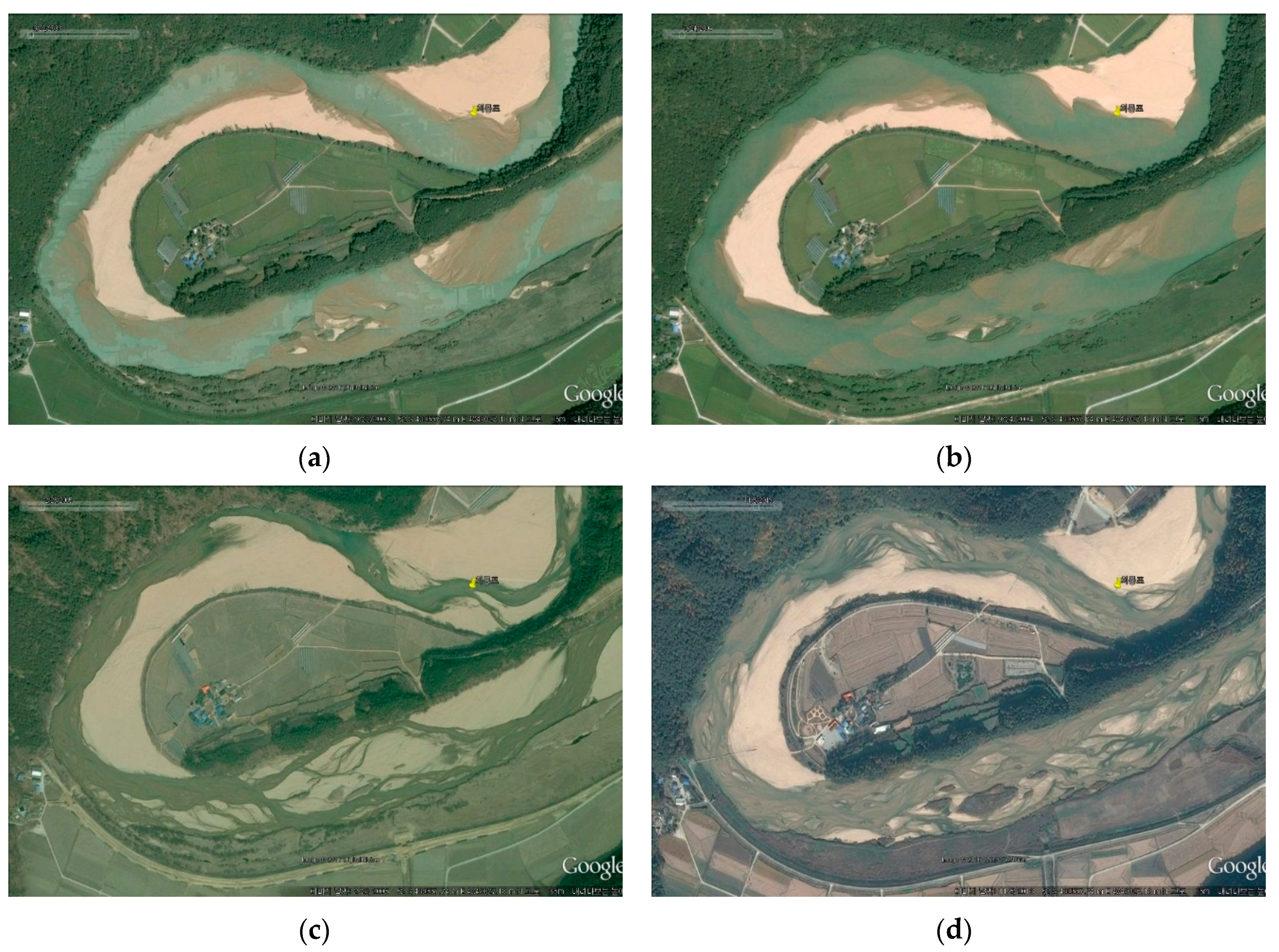
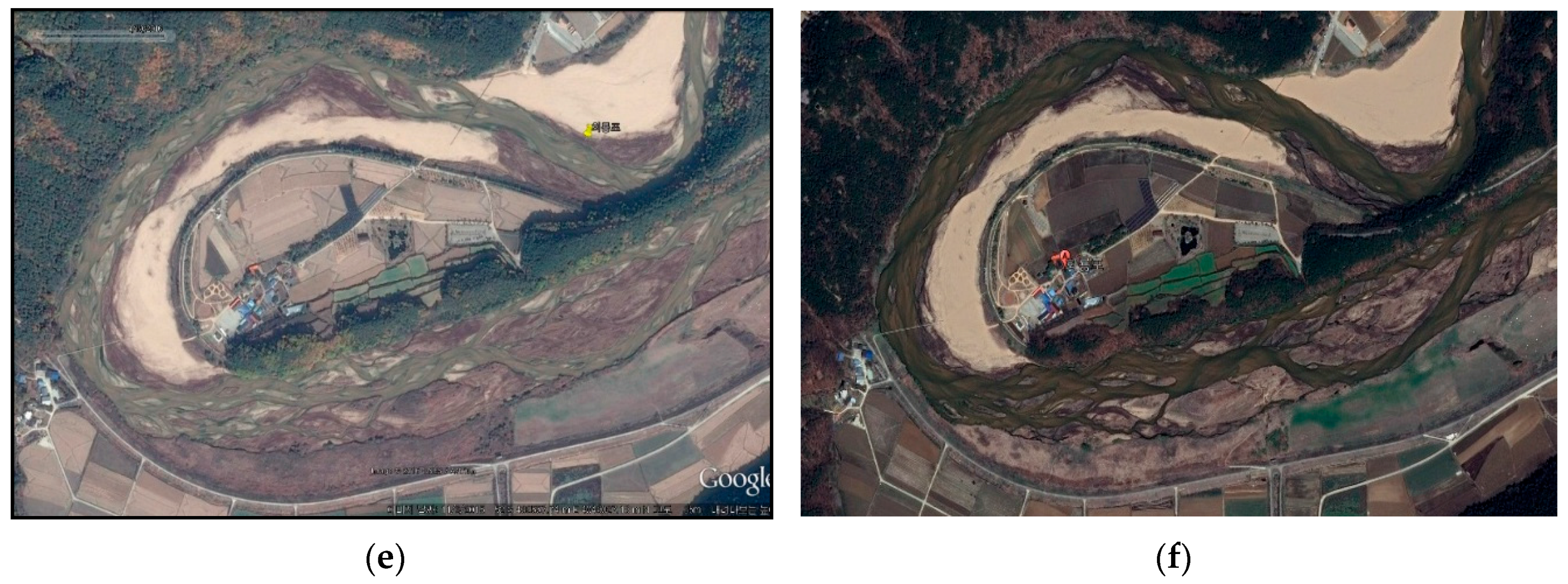
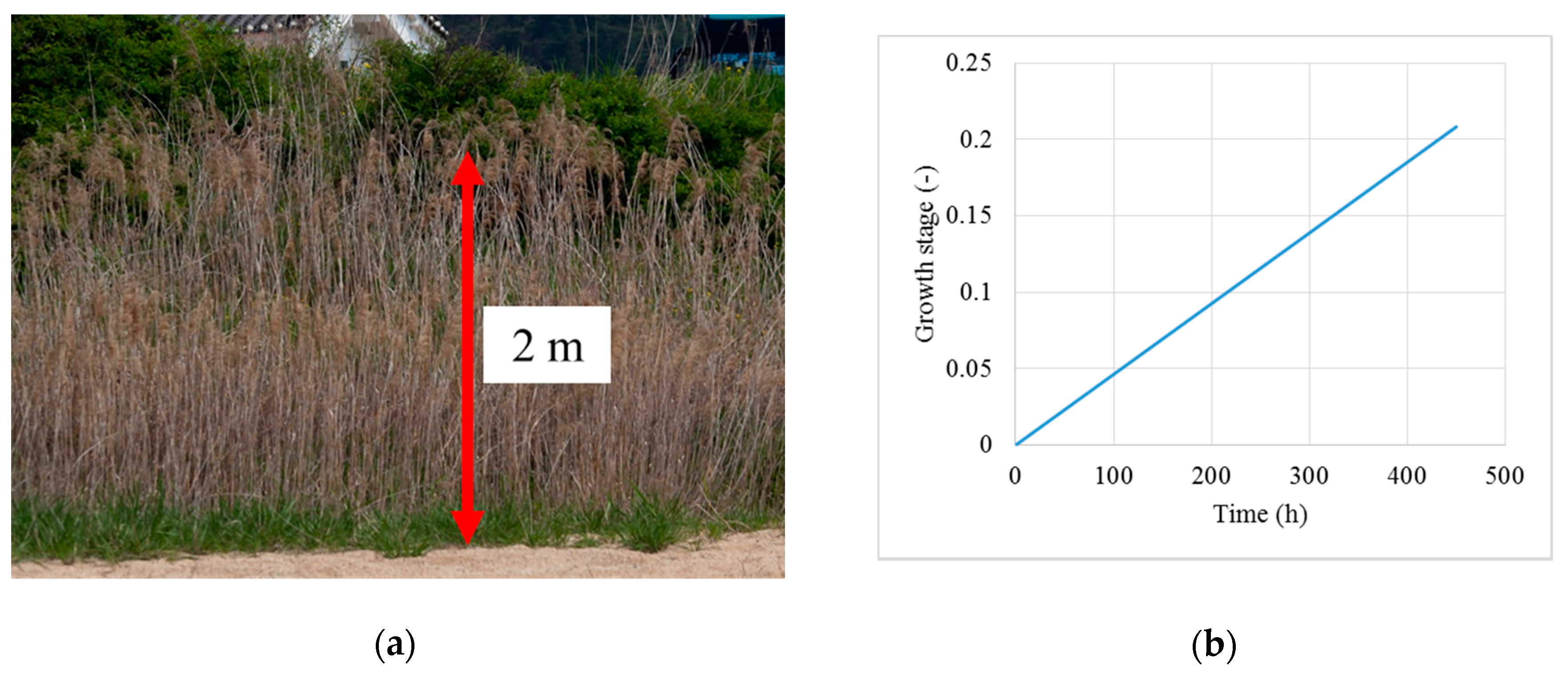
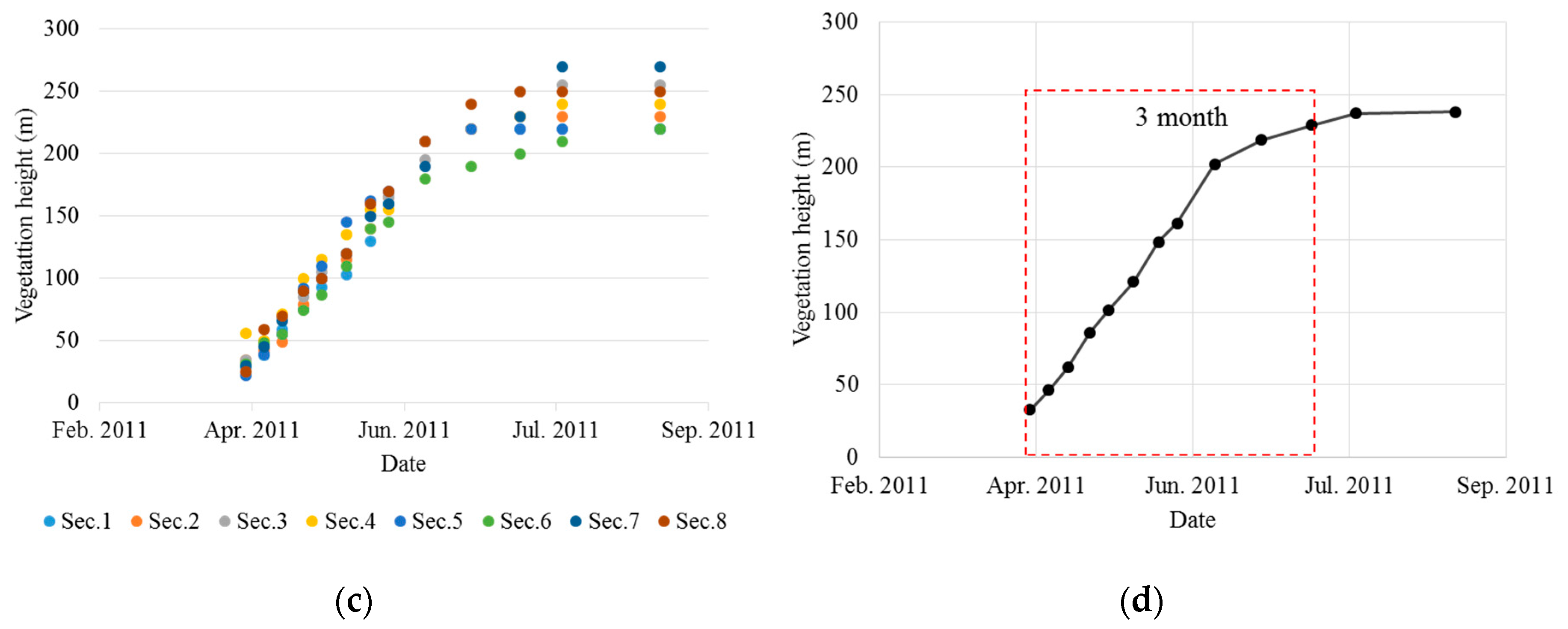
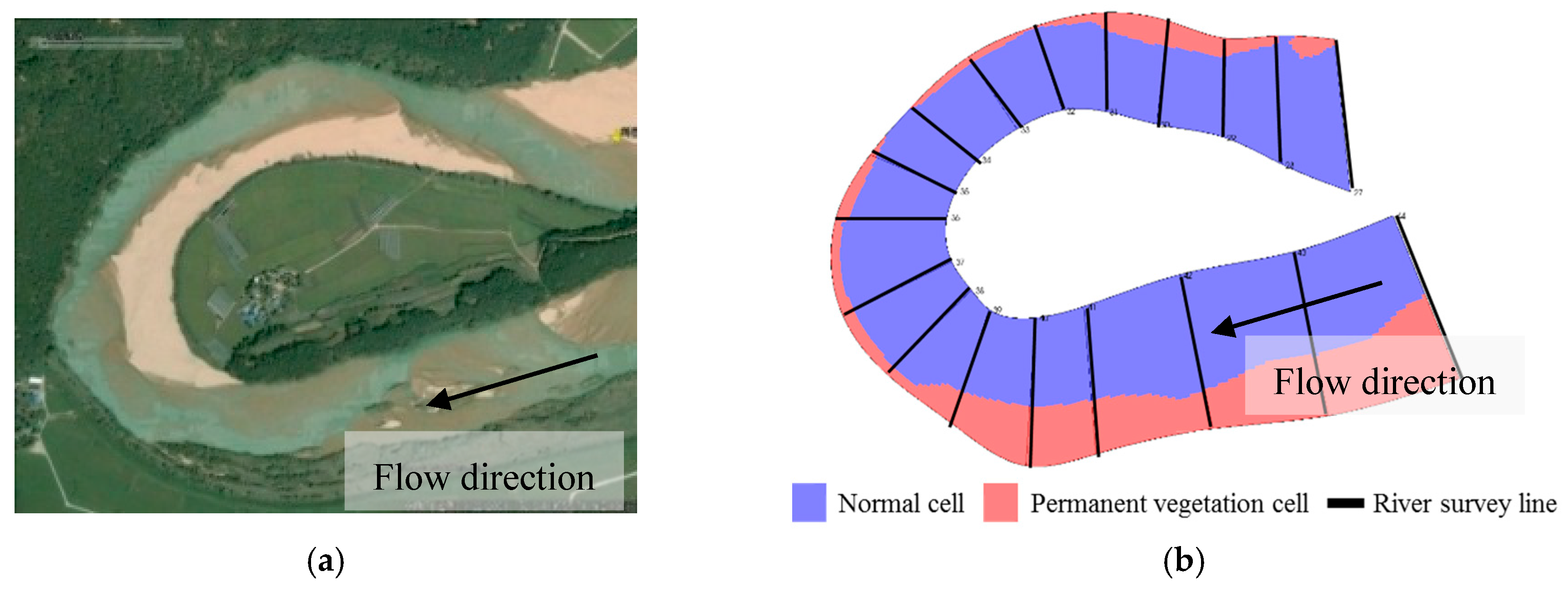

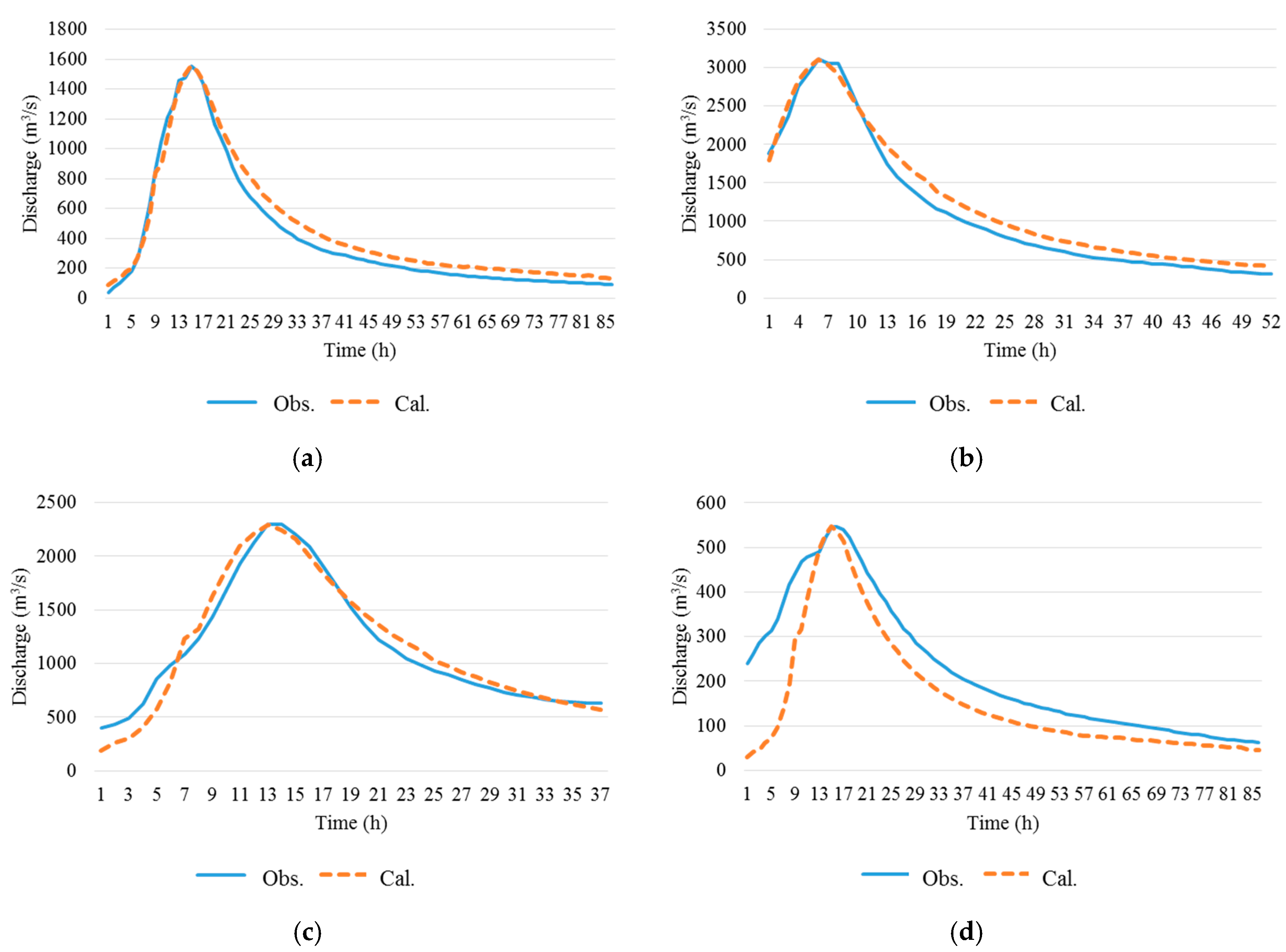

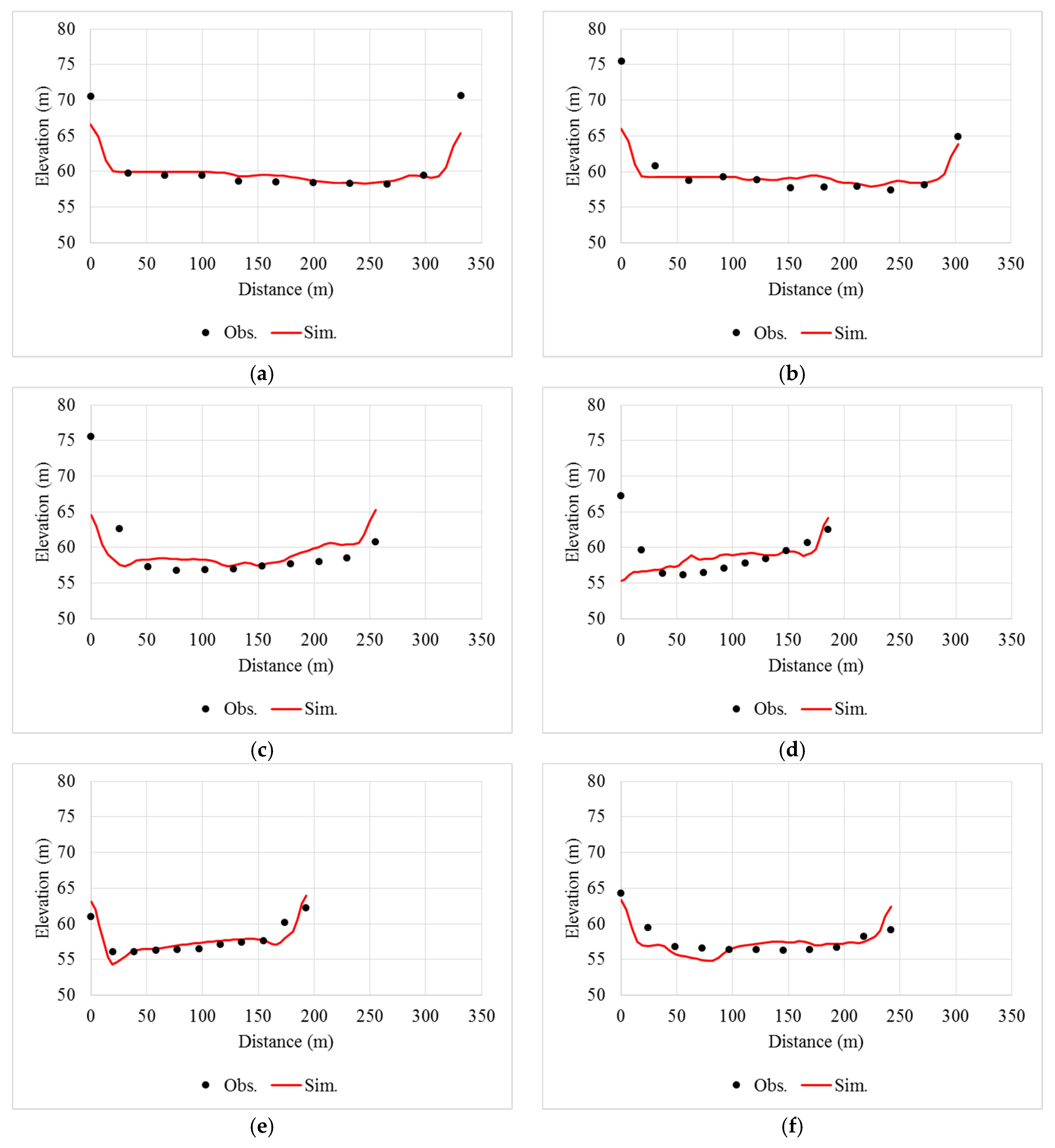



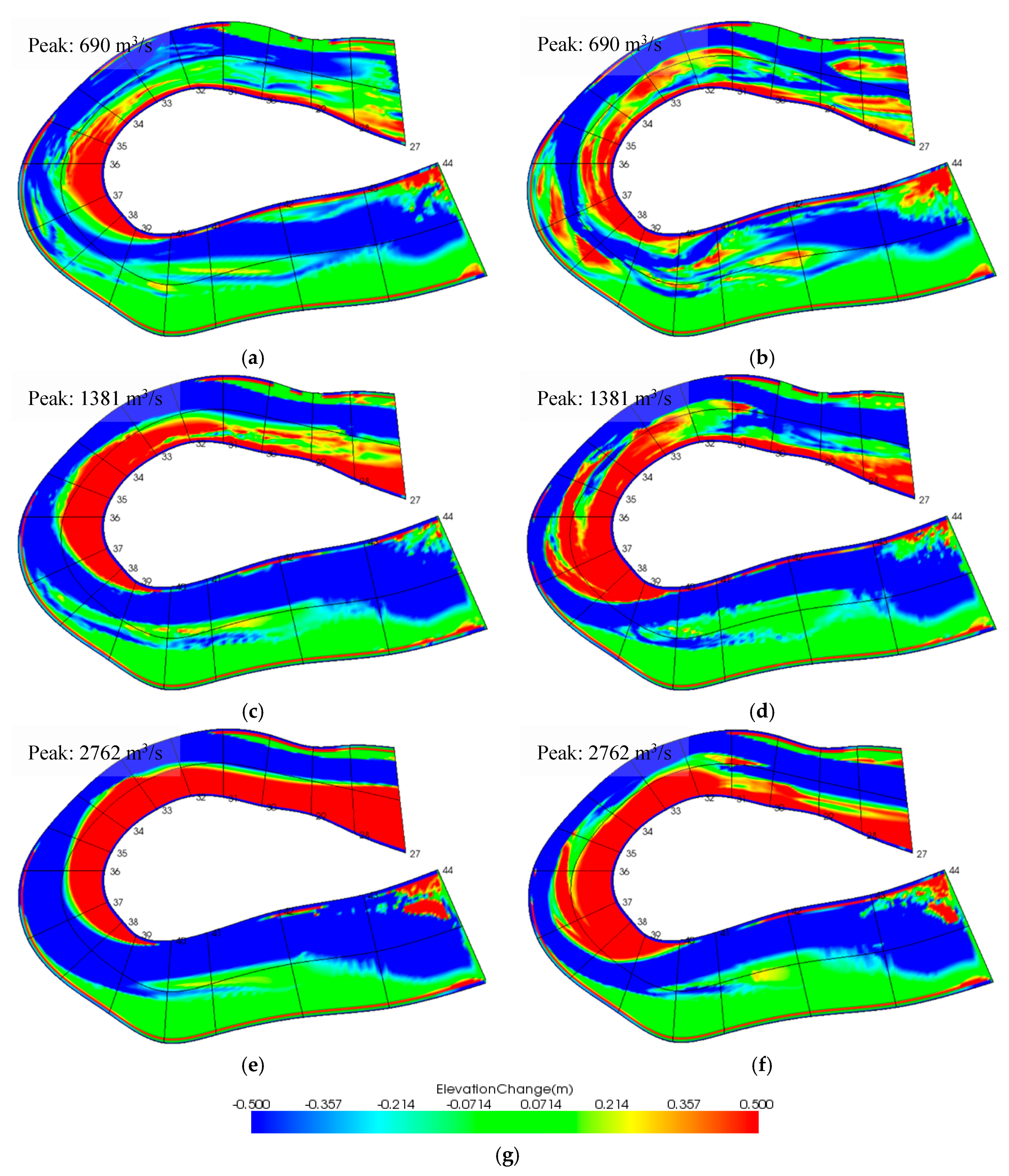
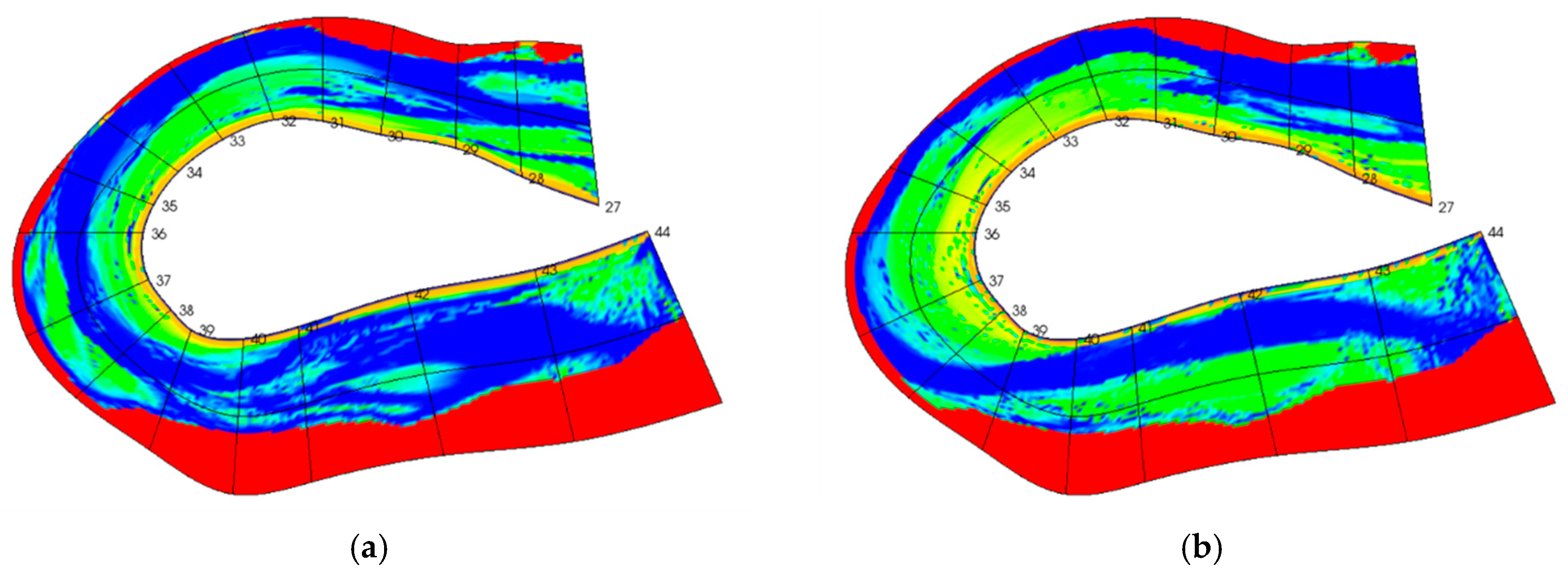
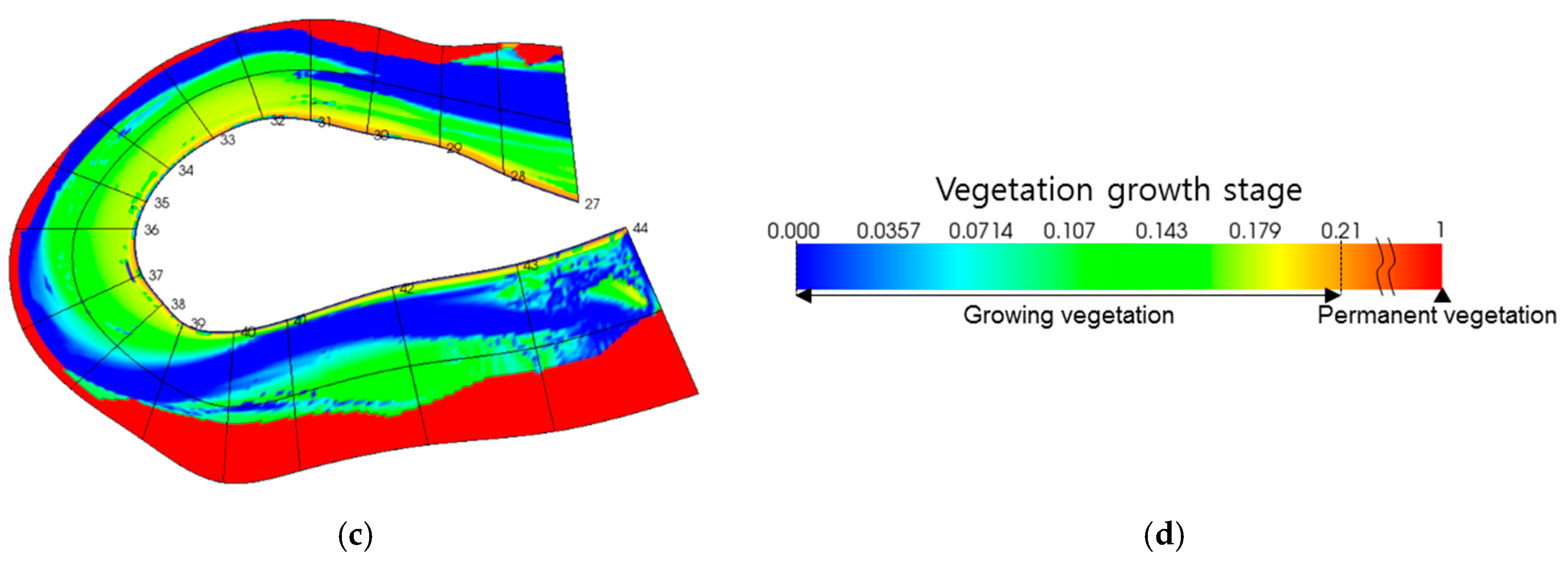

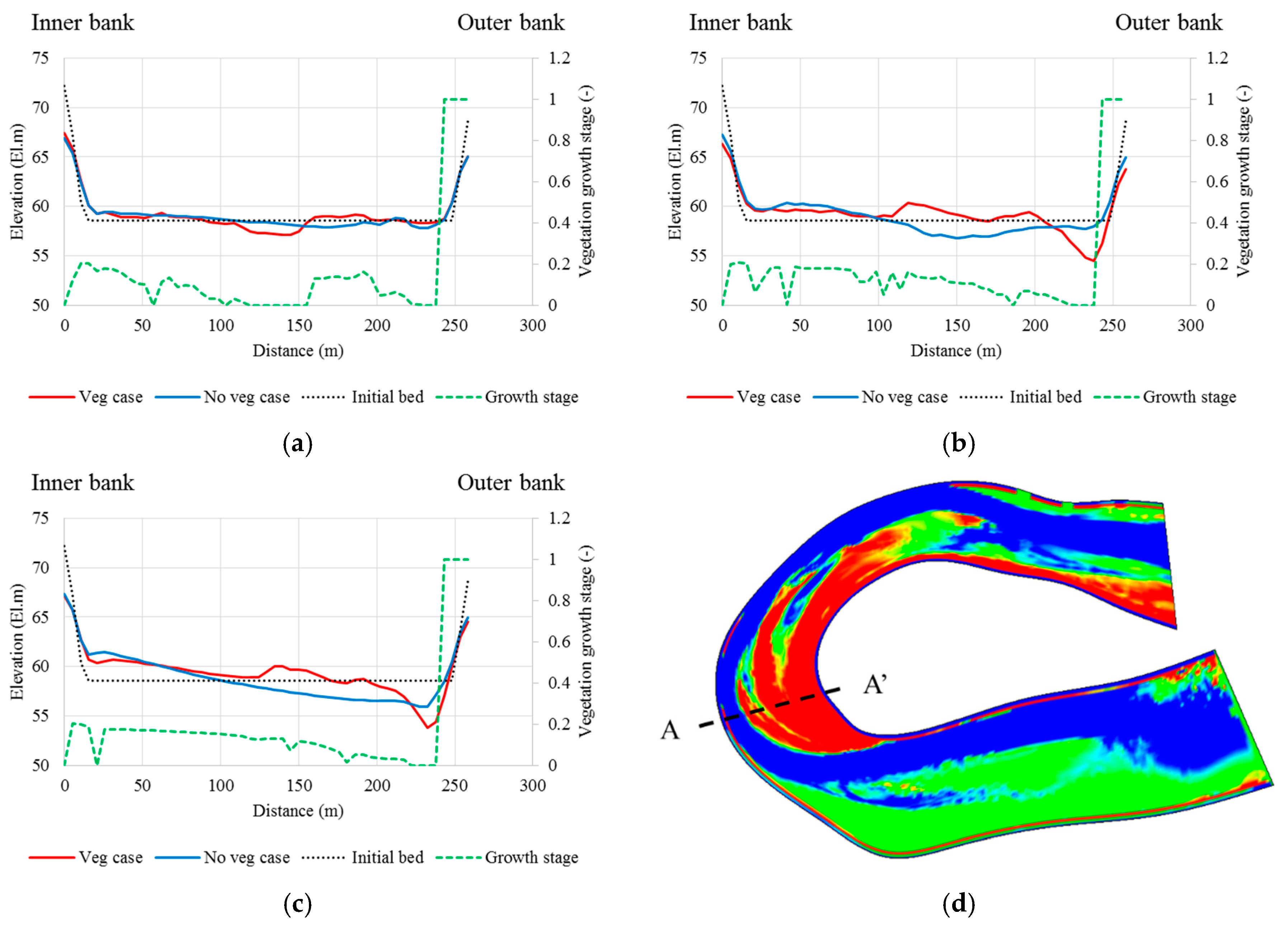
| Parameter | Value | Model |
|---|---|---|
| The von Karman constant (κ) | 0.4 | Zero Equation |
| Mean diameter of bed load ( | 1.49 mm | Sediment transport |
| Manning roughness coefficient () | 0.016 s/m1/3 | Sediment transport |
| Critical Shields number ( | 0.0374 | Sediment transport |
| The number of vegetation in unit area () | 95.34 EA | Vegetation |
| Coefficient of Drag force for vegetation () | 0.7 | Vegetation |
| Maximum growth stage () | 0.21 | Vegetation |
| Critical erosion depth of Vegetation decay (root length) | 0.8 m | Vegetation |
| Angle of repose for bed material ( | 30 | Slope failure |
| No. | Peak Discharge (m3/s) | Total Flood Duration (h) | Growing Vegetation | Permanent Vegetation |
|---|---|---|---|---|
| Run-1 | 690 | 450 | No | Yes |
| Run-2 | 1381 | 450 | No | Yes |
| Run-3 | 2762 | 450 | No | Yes |
| Run-4 | 690 | 450 | Yes | Yes |
| Run-5 | 1381 | 450 | Yes | Yes |
| Run-6 | 2762 | 450 | Yes | Yes |
© 2018 by the authors. Licensee MDPI, Basel, Switzerland. This article is an open access article distributed under the terms and conditions of the Creative Commons Attribution (CC BY) license (http://creativecommons.org/licenses/by/4.0/).
Share and Cite
Kang, T.; Kimura, I.; Shimizu, Y. Responses of Bed Morphology to Vegetation Growth and Flood Discharge at a Sharp River Bend. Water 2018, 10, 223. https://doi.org/10.3390/w10020223
Kang T, Kimura I, Shimizu Y. Responses of Bed Morphology to Vegetation Growth and Flood Discharge at a Sharp River Bend. Water. 2018; 10(2):223. https://doi.org/10.3390/w10020223
Chicago/Turabian StyleKang, Taeun, Ichiro Kimura, and Yasuyuki Shimizu. 2018. "Responses of Bed Morphology to Vegetation Growth and Flood Discharge at a Sharp River Bend" Water 10, no. 2: 223. https://doi.org/10.3390/w10020223





